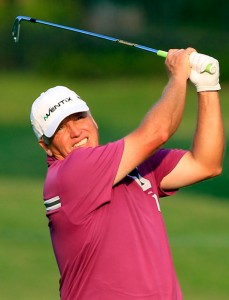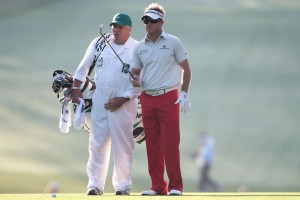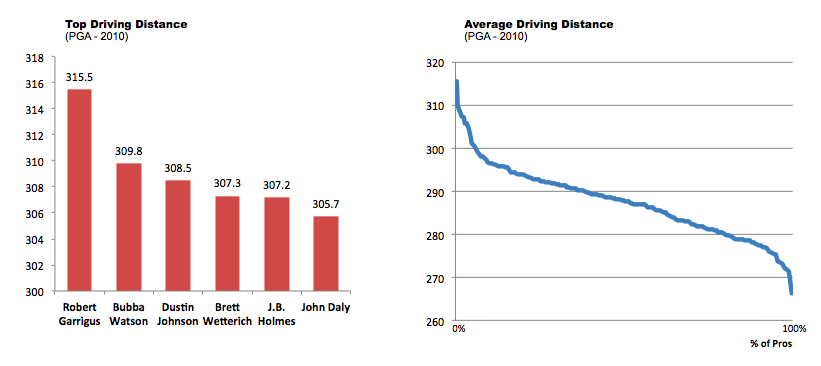More than enough has been said and written about Tiger’s problems over the past two years. We thought we’d hide all the noise, and just share with you a great golf swing.
For more versions of Tiger’s swing, you can click here, here, and here.

The Scratch Pad – MyScorecard Blog
Your Online Golf Handicap Blog
The winnerof six majors and ranked Number 1 in the world for 98 weeks, Sir Nick Faldo was once considered the best the world. In particular, his swing was admired for its consistency under pressure and his ability to deliver “precision strikes”.
How did he get such a precision swing? It was actually built by David Ledbetter over a period of several years, by dissecting each part and then building it up again. Once the pieces were set, they were put together in a full rhythm once again.
When Faldo discusses the keys to his swing, like Hogan he focuses on his right knee – however unlike Hogan he keeps the knee back for a split second before bringing it through the swing. That difference may be more style than substance. As described in Concept Golf, one of our favorite explanations of the golf swing, weight transfer and the lower body (in particular the right knee) will always play a key role in a good golf swing.
Angela Park is not a household name, but she has a beautiful swing.
Hailing from Brazil, Angela Park is in her fourth year on the LPGA tour. Has she ever won a tournament? Nope. Is she a household name? Nope. But does she have a beautiful swing? Yes indeed..
Spend a few minutes watching the video below, and you can’t help but be infected by the simplicity, the great rhythm and the superb form.
Now go out on the range and hit some balls. And be amazed and what a little tempo and relaxed form will do for you.
This from our friends over at 72strokes, where they covered a great story on Casey Martin and his 4-year legal battle with the PGA Tour that ended in 2001. Martin was a three-time all Pac-10 and was a member of Stanford University’s NCAA Championship team in 1994. He suffers from a rare and painful leg disability, fought the PGA Tour for the right to use a golf cart in competition. He ultimately took his case all the way to the Supreme Court where he emerged victorious.
Riding in a cart didn’t turn out to be the advantage than many though it would be:
Maybe on a 120-degree day or on a really hilly course it helped to ride,” Martin said. “But I certainly wish I could’ve walked. The rhythm of the game at a competitive level is a walking rhythm, not a riding rhythm.”
After struggling to remain competitive on the golf course, Martin retired from professional golf five years ago. He’s now the head coach for the University of Oregon’s golf team, which he’s turned into a national powerhouse.
Overall, Casey Martin’s PGA story wasn’t filled with big wins – He played a year on the PGA Tour, but mostly knocked around golf’s minor league. His accomplishments were not big, but they were meaningful.
“In the end it worked out great,” Martin said. “I got a chance to legitimately pursue my career. It made a massive impact on my life for the better.”
Martin’s fight has served as inspiration for other athletes to pursue their dreams, and a lesson that a disability doesn’t have to come with preset limits.
In a tournament earlier this year, Ian Poulter sprinted from the 17th tee all the way to the green, putted out, and then teed off on 18 while his playing partner Dustin Johnson was still on the green and Phil Mickelson’s group was just walking off the 18th tee.
Why the rush?
By putting a ball in play on the 18th, Poulter and Johnson were able to finish their round even though the horn sounded to end play. If the horn had sounded while they were still playing the 17th, they would have had to show up for a 7:30ish tee time this morning, play one hole, and then hang around for a few hours to start their 4th round.
I think DJ owes Poulter a drink for getting him a few extra hours of sleep this morning.
Derek is a guest blogger on the Scratch Pad. To view more of his daily posts, visit 72strokes.com
When Gary Player says it’s the greatest swing of all time and when Lee Trevino says that’s the swing he would teach to his children, then that’s a swing to pay attention. We’re talking about Slammin’ Sammy, holder of the record for most wins on the PGA tour at 82 (or 83 as some proponents would contend).
Sam was always focused on Rhythm. He learned to play barefoot, which is perhaps his secret. There are many beautiful swing montages of Sam’s swing. Just watching them is enough to improve your game.
Sam Snead is perhaps best described by Jim Mclean, himself one of the best teachers in the game:
Some have said he was the greatest athlete ever to pick up a golf club. Some say he was the greatest player of all time. Some refer to his 81 victories on the PGA Tour, the most ever. Some say his shooting under his age in a PGA Tour event was the most amazing fact (a 66 at age 67). Some might argue it was that he shot 60 at age 71 on the challenging, par-72 Upper Cascades course. It’s hard to hang one tag on Sam Snead, but if I had to, I believe it would be “He had the sweetest swing in the history of the game”.
 Understanding how good the pros really are is best illustrated by the story of Kip Henley
Understanding how good the pros really are is best illustrated by the story of Kip Henley
All Kip Henley ever wanted was to be a tour player. His obsession began at age 5 when his mother, who worked folding boxes at the Arnold Palmer company in Chattanooga, provided her young son with a cut-off set of Arnold Palmer signature clubs.
Kip gave up his amateur status in 1982, trying tour school. No one tried harder and got less out of it than ol’ Kipper,” he said. “I paid a fortune in Q-School fees for probably 12 years.” After running out of funds, he turned to the life of a club pro and became a Class A PGA professional.
He has maintained his Class A standing with the PGA of America for years. Over the past 5 years, he made the transition to caddying for Tour Pro Brian Gay (that’s Kip in the white jumpsuit with Brian at the Masters) .  In fact, Kip picked up $100,000 a couple of years ago when Gay won the FedEx/St. Jude Classic in Memphis.
In fact, Kip picked up $100,000 a couple of years ago when Gay won the FedEx/St. Jude Classic in Memphis.
Last fall, for reasons he still doesn’t understand, Kip Henley played in and won the Tennessee PGA Section championship, “even though I hadn’t broken par all year.” Talk about the blind squirrel finding a nut. “I shot 10 under for 54 holes,” Henley said. “Like I said, a miracle. I stood on the 16th hole in the final round and made birdie on 16, 17 and 18, with my hands shaking.” Continue reading “They’re even better than you thought”
Any swing series wouldn’t be “great” without a tribute to Ben Hogan.
Hogan is credited with the modern swing, and is most recognized as having been the greatest ball striker ever to have played golf . His swing introducing both technical precision and athletic prowess, and is summarized in his book Five Lessons: The Modern Fundamentals of Golf, one of the most widely read golf tutorial ever written.
What does being the best ball striker ever actually mean? It means that in one of his more famous tournaments he hit 139 out of 141 with good to perfect execution. He had such mastery over his swing that many people began looking for his “secret”. One major theory had to do with his right knee – and how it was used to keep his swing “automatic”. This was something Hogan stressed in his book and lessons – including the video above.
We’ve received a lot of feedback from our members about adding in more content to help improve their games. We’ll be doing just that, starting with a series of posts that highlight the swings of great professional golfers.
We’ll be starting out with a golfer who the London Times said “brought passion and risk to golf” and whom a fellow pga tour pro described as “playing golf shots I don’t even see in my dreams” – the late Seve Ballesteros.
Seve joined the tour in 1974 at age 16, and won 91 tournaments (including 50 on the European Tour) over the next 33 years. He was known for his shot-making flair, with an expert sense of feel and extreme hand control that let him shape and finesse shots that amazed the crowd and his competitors.
A great summary of his swing style is found in his obituary that ran in the Economist magazine
Luck, said some. Miraculous said others, as they sighed at his soft blasts out of bunkers on to the green, or the fluid grace of his swing. Commentators talked of natural genius, as though he was still a seven-year old whacking a pebble with a homemade club on a beach in Cambria. His impoverished family put it down to destino. Such talk annoyed him. It was all hard graft and iron discipline: hitting a ball, alone, for hours. It started in boyhood, putting into tomato cans on a bumpy two-hole piece of field on his parents’ farm, or driving into a fishing net hung in the barn. He reckoned he had hit 1,000 balls a day. Because he had only one club, a 3-iron, he learned how to do everything with it: low, powerful shots, high soft-landing shots and impossible recovery shots out of long, tangled grass. He could improvise his way out of anything.
MyScorecard’s You versus the Pros performance report offers you the ability to compare your skill against your favorite PGA and LPGA professional.
But how good do you have to be to graduate from Q-School?
We’ve run the numbers for the 2010 PGA and LPGA tour season in terms of 3 of the most often tracked statistics: Driving Distance, Greens in Regulation, and Putting.
Driving Distance
Averaging 315+ yards per drive, Robert Garrigus is far and away the longest driver on the PGA tour, with Bubba Watson leading the rest of the pack. But do you have to be a 300+ yard driver to be on the Men’s Tour? Not quite so. The vast majority of PGA tour players drive between 280 and 300 yards – but you’d better be at least 275 or longer if you want to play on the tour.

Greens in Regulation (GIR)
In contrast to the Men’s tour, it is the LPGA pros that lead in GIR accuracy. Continue reading “How do you compare to the best?”